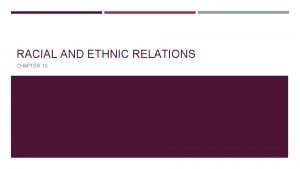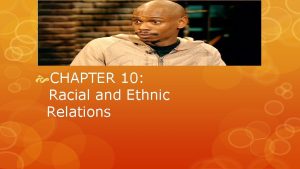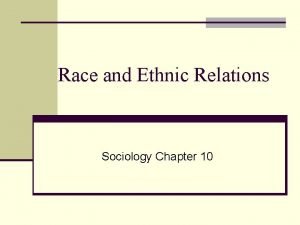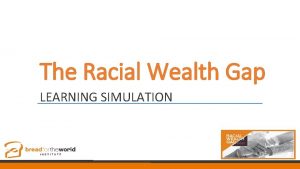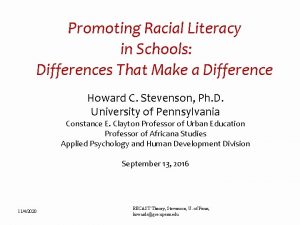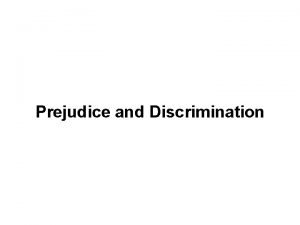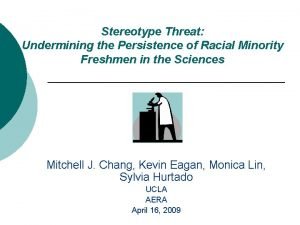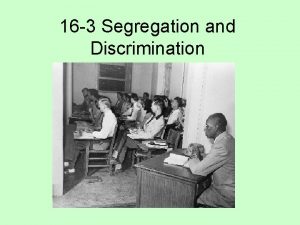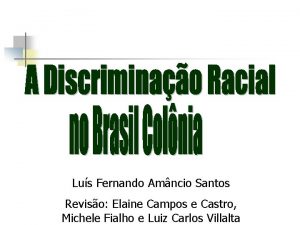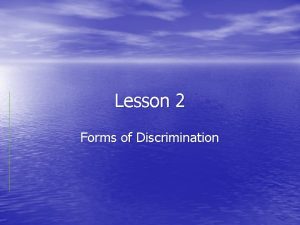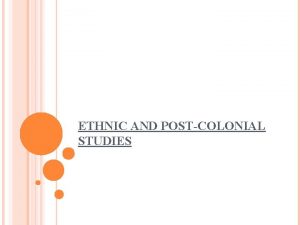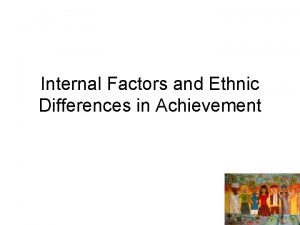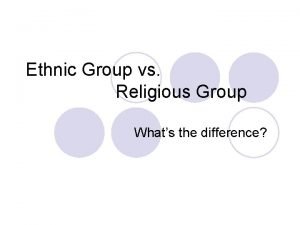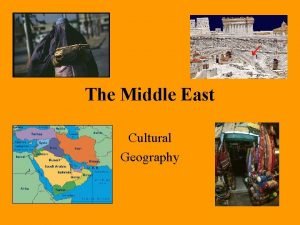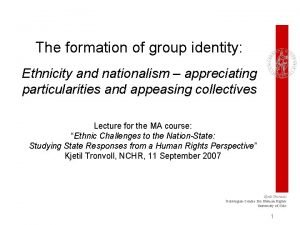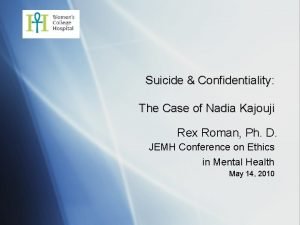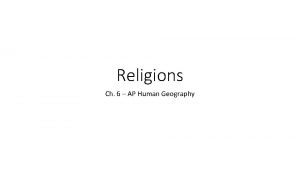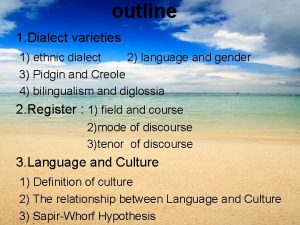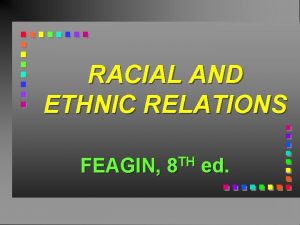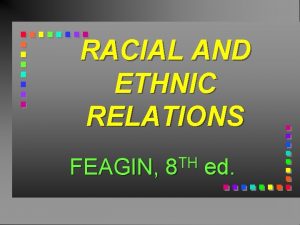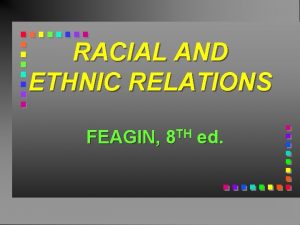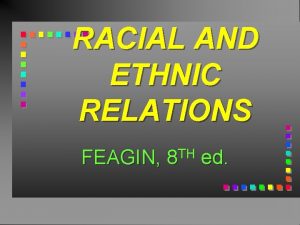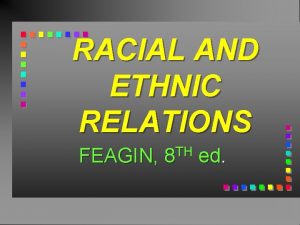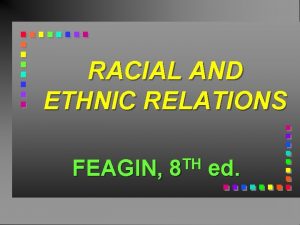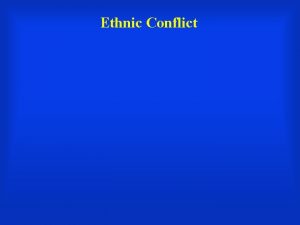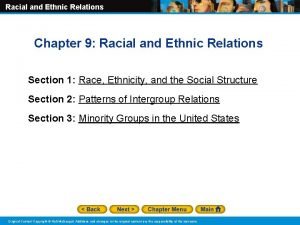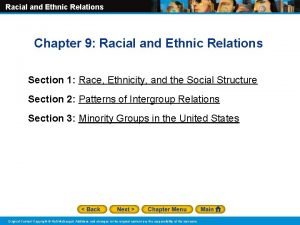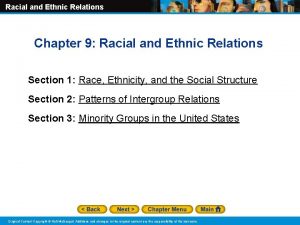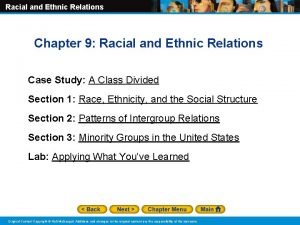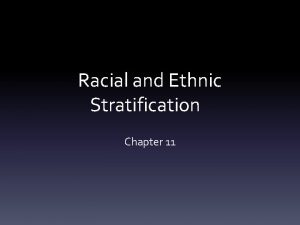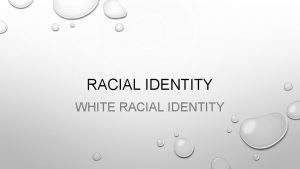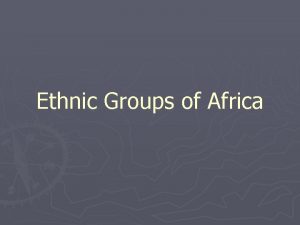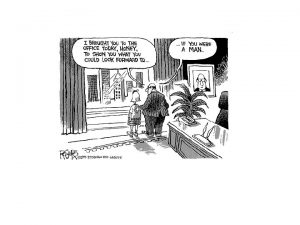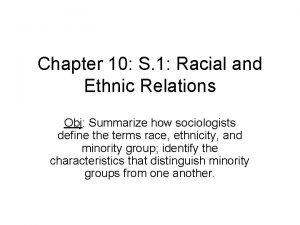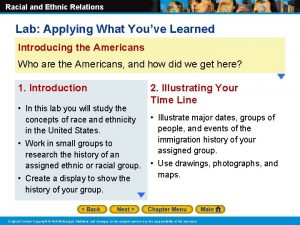RACIAL AND ETHNIC RELATIONS FEAGIN TH 8 ed





























- Slides: 29

RACIAL AND ETHNIC RELATIONS FEAGIN, TH 8 ed.

ONGOING RACIAL AND ETHNIC ISSUES IN THE UNITED STATES CHAPTER 13

• • U. S. began as land of great promise for colonists who came from Europe Currently, U. S. society is undergoing important changes in its racial and ethnic composition • • Challenges of white domination of US society in terms of white population and of white power and privilege Ongoing demographic shift significant for European Americans • Not been a statistical minority of North American population since 1700 s

• • Even liberal analysts expressed variations on strongly negative view of cultural pluralism and multiculturalism Historian Arthur Schlesinger, Jr. • • Wrote about multiculturalism as dominating all levels of education In his view, involves • “astonishing repudiation” of “a unifying American identity” and an “assault on the Western tradition” by multicultural “tribalism”

• Many analysts see efforts to create a multiracial democracy whose core culture is no longer European as a disturbing challenge to European values and interests and to “European civilization”

A NATION OF IMMIGRANTS • U. S. has always been a nation of immigrants • • • Recurring immigration is its uniqueness and one of its strengths European countries supplied nearly 60% of the 70 million immigrants who legally entered the U. S. over 185 -year period Distinctive economic and political conditions in U. S. and sending countries have shaped which countries supply immigrants and how many

* Data for years prior to 1905 refer to country of origin; data from 1905 to 2005 refer to country of last residence. Continued on next slide

* Data for years prior to 1905 refer to country of origin; data from 1905 to 2005 refer to country of last residence. Continued on next slide

* Data for years prior to 1905 refer to country of origin; data from 1905 to 2005 refer to country of last residence.

• • Many indigenous people already present when strangers arrived Political actions by colonial and US governments long helped determine character of immigration patterns In U. S. , leading officials often used restrictive laws to control migration according to their racial and ethnic prejudices and preferences Beginning in 1965, openly exclusionary and racist quotas replaced with general limits on number of immigrants allowed

• 1990 Immigration Act • • Set official annual limit of all legal immigrants at 675, 000 Affected countries from which many people seek to emigrate, such as Asian countries Contrasted with unlimited immigration allowed before 1910 when potential immigrants were European Recently, immigration and proposed immigration restrictions debated by Congress, public, and media commentators

• • • Most respondents in opinion surveys indicate they feel diverse cultural composition of U. S. is an important asset Though many respondents of surveys believe that immigrants are taking away U. S. jobs, most research shows that immigrants do not take away more jobs than they create Over past decade, growing misinformation about and hostility toward immigrants seldom countered by educators and public officials

• • Some social analysts argue that immigrants make mostly positive contributions to U. S. Over next half-century, U. S. will likely face shortage of young workers as large numbers of baby boomers retire • • Aged population will grow to more than 1/5 th of population and additional numbers will near retirement age Current workforce insufficient to meet heavy demands for health care and other public and private services aging population will require

THE MELTING POT • Never been consensus on how new immigrants are to be incorporated into this society • • Pressures for cultural assimilation matched by immigrants’ desire to maintain their cultures Israel Zangwill – The Melting Pot • • Optimistic image of crucible that melts many different groups to form “American blend” Symbolizes mutual adaptation process in which old and new groups blend together on more or less equal basis

• • Yet, actual intergroup adaptation usually involved one-way assimilation and group conflict Assimilation theorists argue that in practice, melting pot has diverged greatly from Zangwill’s ideal • Immigrant adaptation typically been in direction of Anglo-conformity as each new group of immigrants gave up much of their cultural heritage for dominant culture

MULTICULTURAL AND MULTIRACIAL DEMOCRACY ISSUES • Multiculturalism • • The idea that modern societies should include and accept diverse cultural groups with equal social and political status Cultural Diversity • Acceptance of the variety of societies or cultures that stress importance of respecting many racial and ethnic groups and subcultures contributing to U. S. development, especially non-European groups

• • Numerous colleges, universities, elementary, and secondary schools developed a few multicultural courses or programs to give voice to racially oppressed people (and sometimes white women) Some publishers and voluntary organizations made multicultural teaching materials more available to colleges and public schools

• Strong version of multiculturalism enthusiastically embraced by numerous scholars and other Americans • • • Seek a sharp reduction in ideological racism and racial and ethnic discrimination as well as greater respect for their home countries and cultures Some white analysts view this as an attack on the dominant Euro-American culture Critics argue that Anglo-conformity still the best assimilation model for non. European groups

• Strong version of multicultural thought suggests U. S. should be viewed as a grand mosaic, not a melting pot • • Country that celebrates diversity with “rainbow” language and framing Strong multicultural analysts believe that vigorous multiculturalism and diversity programs provide necessary corrective to dominance of Euro-American culture

• • • Many multicultural studies have encouraged looking at traditionally excluded cultures and studying them on their own terms rather than through eyes of the dominant class Debates have become heated when they encompass issues of racial and ethnic inequality and white privilege and power Power-conflict analysts argue the multiculturalism curricula should acquaint all students with perspectives on nondominant racial and ethnic groups

EQUALITY AND A PLURALISTIC DEMOCRACY • • • Equality and social justice sought by all subordinate racial and ethnic groups has an ancient heritage Over following centuries, U. S. conception of who could claim equality and justice has become more inclusive Between 1800 s and 1900 s, dramatic economic development brought opportunity and advancement to millions of European immigrants

• • Rosy view of U. S. society as long committed to “liberty and justice for all” remains, as always, very inaccurate Optimistic picture of U. S. equality and freedom glosses over continuing discrimination faced by Americans with roots outside of Europe • • Over the course of U. S. history significant improvements have occurred Yet, major problems of continuing racial and ethnic discrimination remain imbedded in the informal operation of the U. S.

• Racial Discrimination: The Present Day 1992 marked 500 th anniversary of Columbus landing • • Celebrations generated protests from many Americans, especially Native Americans Worked hard to counter mythical images of beneficent European explorers “discovering” America Asians struggle with anti-Asian sentiment and discrimination Latinos continue to face problems in securing justice and equality

• • African Americans face many great obstacles in securing equality and justice promised by the American creed Decades after civil rights laws passed, racial and ethnic discrimination remain very serious and widespread • Many federal and local government agencies, and private institutions, have backed away from effective programs to counter persisting discrimination

• Many research studies show that discrimination against African Americans, mainly by white Americans, remains common • • Employment, housing, and education Across the country African Americans and other Americans of color have protested because of continuing frustration and anger over pervasive individual and institutional discrimination

CONCLUSION • • Even though U. S. population has grown substantially in recent decades, without immigration many major cities in which whites departed would have experienced serious population declines Ongoing population shift from predominantly white country to one in which no racial or ethnic group has a population majority has significant economic, social, and political implications

• By 2050 s, if not before, demographic forecasts suggest that majority of working Americans will no longer be white • • Majority of older retired population will be white Intergroup debates about and conflict over sociopolitical power, discrimination, diversity, and related public policy issues, such as affirmative action, are likely to increase

• • Ideals of greater racial and ethnic equality and justice have long been part of an authentic American dream and framing of a better society Roots of that dream lie in many Americans’ aspirations for liberty, human rights, and social justice for over four centuries

• Expansion of human rights, equality, and justice often resulted from the effective and large-scale organization of racially and ethnically oppressed people and their allies against persisting racial and ethnic oppression
 Chapter 10 racial and ethnic relations
Chapter 10 racial and ethnic relations Chapter 10 racial and ethnic relations
Chapter 10 racial and ethnic relations Chapter 10 racial and ethnic relations review worksheet
Chapter 10 racial and ethnic relations review worksheet Feagin mill middle school
Feagin mill middle school Black studies and the racial mountain
Black studies and the racial mountain Employee relations in public relations
Employee relations in public relations Jim crow laws in what region or regions did it exist
Jim crow laws in what region or regions did it exist Racial wealth gap simulation
Racial wealth gap simulation Promoting racial literacy in schools
Promoting racial literacy in schools Anti imperialist league apush
Anti imperialist league apush Racial prejudice
Racial prejudice Don tiburcio noli me tangere
Don tiburcio noli me tangere Racial insults
Racial insults In what region did racial etiquette exist
In what region did racial etiquette exist Cartel ley organica contra la discriminacion racial
Cartel ley organica contra la discriminacion racial Democracia racial
Democracia racial Lesson 2: racial discrimination
Lesson 2: racial discrimination Ethnic studies and postcolonial criticism
Ethnic studies and postcolonial criticism Ethnocentric curriculum
Ethnocentric curriculum What's the difference between ethnic and religious group
What's the difference between ethnic and religious group How are ethnic groups and religious groups related
How are ethnic groups and religious groups related Judaism universalizing or ethnic
Judaism universalizing or ethnic Cultural geography of the middle east
Cultural geography of the middle east Ethnic boundary marker
Ethnic boundary marker Nadia kajouj
Nadia kajouj Government type in spain
Government type in spain Ethnic religions ap human geography
Ethnic religions ap human geography Example of universalizing religion
Example of universalizing religion Ethnic formation
Ethnic formation Ethnic dialect examples
Ethnic dialect examples
